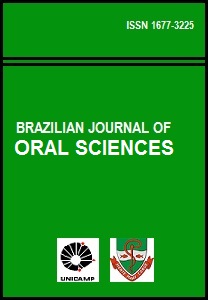Abstract
The aim of this study was to evaluate the thermocycling effect on microhardness of laboratory composite resins. 30 disks were fabricated, 5 mm of diameter and 2mm of width, using 3 laboratory resins: G1 (n=10) - RESILAB MASTER (Wilcos-Brasil), G2 (n=10) - Vita VMLC (VITA Zahnfabrik-Germany), and G3 (n=10) - Vita Zeta (VITA Zahnfabrik-Germany). Vickers microhardness (HV) of all specimens was evaluated using a microhardness tester FM-700 (Future Tech- 50 g/10s). The specimens were measured before and after the thermocycling (3.000 times and 12.000 times - 5° /55°C±1). The microhardness values before cycling were (mean±SD): G1: 55.50±4.6; G2: 35.54±2.5; G3: 27.97±1.6.; after 3.000 thermocycles: G1: 55.54±3,9; G2: 29.92±2,73; G3:21.01±1.4 and after 12.000 cycles G1:54.27±3.2; G2: 30.91±1.6. G3: 23.81±0.9. Variance analysis (ANOVA) and Tukey’s test was accomplished (p<0,05), the highest microhardness values were observed in G1; G2 and G3 showed reduction of microhardness values. It was concluded that, after thermocycling, the tested laboratory composites resins are susceptible to the decrease of surface microhardness.
References
Touati B, Akdan N. Second generation laboratory composite resins for indirect restorations. J Esthet Dent. 1997, 9: 108-18 2. Touati B. The evolution of aesthetic restorative materials for inlays and onlays: a review. Pract Periodontics Aesthet Dent. 1996, 8: 657-66.
Roulet JF. Benefits and disadvantages of tooth colored alternatives to amalgam. J Dent. 1997; 25: 459-73.
Cesar PF, Miranda Junior WG, Braga RR. Influence of shade and storage time on flexural strength, flexural modulus, and hardness of composites used for indirect restorations. J Prosthet Dent 2001; 3: 289-96.
Montes-G GM, Draughn RA. In vitro surface degradation of composites by water and thermal cycle. Dent Mater. 1986; 2:193-7.
Crim GA, Mattingly SL. Evaluation of two methods for assessing marginal leakage. J Prosthet Dent. 1981; 45: 160-3.
Craig RG. Materiais dentários restauradores. 11. ed. São Paulo: Santos; 2004 8. Okada K, Asada M, Omura L, Yamauchi J. A new crown and inlay material “ESTNIA”. J Esthet Dent. 1998; 11: 121.
Sugita T, Nakamura T, Koh T, Nonaka Y, Tanaka K, Mutobe F et al. Physical properties and clinical application of newly highly filler filled materials “Hybrid Ceramics” for posterior prosthesis. J Esthet Dent. 1998; 11: 107.
Anusavice KJ. Phillips science of dental materials. 11. ed. Philadelphia: Saunders; 2003.
Ferracane JL. Current trends in dental composites. Crit Rev Oral Biol Med. 1995; 6: 302-18.
Chadwick RG, McGabe JF, Walls AGW, Storer R. The effect of storage media upon the surface micro hardness and abrasion resistance of three composites. Dent Mater. 1990; 6: 123-8.
Ferracane JL, Berge HX, Condon JR. In vitro aging of dental composites in water – effect of degree conversion, filler volume, and filler-matrix coupling. J Biomed Mat Res. 1998; 42: 465- 72.
Kawano F, Ohguri T, Ichikawa T, Matsumoto, N. Influence of thermal cycles in water on flexural strength of laboratoryprocessed composite resin. J Oral Rehabil. 2001; 28: 703-7.
Rossomando KJ, Wendt Sl Jr. Thermocycling and dwell times in microleakage evaluation for bonded restorations. Dent Mater. 1995; 11: 47-51.
Gale MS, Darvell BW. Thermal cycling procedures for laboratory testing of dental restorations. J Dent. 1999; 27: 89-99.
Mandikos MN, McGivney GP, Davis E, Bush, PJ, Carter JM. A comparison of the wear resistance and hardness of indirect composite resins. J Prosthet Dent. 2001; 85: 386-95.
Tantbirojn D, Versluis A, Cheng Y, Douglas WH. Fracture toughness and microhardness of a composite: do they correlate? J Dent. 2003; 31: 89-95.
Harrison A, Draughn RA. Abrasive wear, tensile strengh, and hardness of dental composite resins - is there a relationship? J Prosthet Dent. 1976; 36: 395-8.
Lappalainem R, Yli-Urpo A, Seppa L. Wear of dental restorative and prosthetic materials in vitro. Dent Mater. 1989; 5: 35-7.
Kawai K, Iwami Y, Ebisu S. Effect of resin monomer composition on toothbrush wear resistance. J Oral Rehabil. 1998; 25: 264-8.
Condon JR, Ferracane JL. In vitro wear of composite with varied cure, filler level, and filler treatment. J Dent Res. 1997; 76:1405- 11.
Drummond JL. Cyclic fatigue of composite restorative materials. J Oral Rehab 1989; 16: 509-20.
Willems G, Lambrenhes P, Braem M, Celis JP, Vanherle G. A classification of dental composites according to their morphological and mechanical characteristics. Dental Materials. 1992; 8: 310-9.
Braem MLA, Davidson CL, Lambrechts P, Vanherle G. In vitro flexural fatigue limits of dental composites. J Biomed Mat Res. 1994; 28: 1397-402.
Yap AUJ, Teoh SH. Comparison of flexural properties of composite restoratives using the ISO and mini-flexural tests. J Oral Rehabil. 2003, 30: 171-7.
Soderholm KJ, Zigan M, Ragan M, Fischlschweiger W, Bergman M. Hydrolytic degradation of dental composites. J Dent. Res. 1984; 63: 1248-54.
Scarret DC, Ray S. The effect of water on polymer matrix and composite wear. Dent. Mater. 1994; 10: 5-10.
The Brazilian Journal of Oral Sciences uses the Creative Commons license (CC), thus preserving the integrity of the articles in an open access environment.

